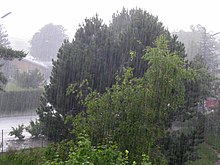Imvula

Imvula ngamaqabaza amanzi ehla evela emafini asesibhakabhakeni angaphezu kwe-0.5 mm ubukhulu bawo. amaqabaza amanzi amalungane-0.2mm ukuya kwi-0.45mm ubukhulu kuthiwa ziidrizzle. Imvula luhlobo lokuphefumla Rain is a kind of precipitation. Precipitation is any kind of water that falls from clouds in the sky, like rain, hail, sleet and snow. It is measured by a rain gauge. Rain is part of the water cycle.
A rainstorm is a sudden heavy fall of rain. It may cause flash floods in valleys. Heavy rain for a long time may make floods on floodplains. Rivers overflowing can destroy houses and drown people. Also, landslides may happen.
Ukwenzeka kwemvula
[tshintsha | Yenza izilungiso kokubhaliweyo]When the Sun heats the ground surface, the ground heats the air. This air rises and cools. When it cools to the dew point, clouds form and rain follows. This type of rainfall often causes summer showers and thunderstorms.
imvula ekhwazwa zintaba
[tshintsha | Yenza izilungiso kokubhaliweyo]Relief rain usually occurs along coastal areas where a line of hills runs along the coast. When wet onshore wind from the sea meets a mountain, hill or any other sort of barrier, it is forced to rise along the slope and cools. When the air temperature falls to its dew point, water vapour condenses to form clouds. When the clouds can no longer hold the water droplets, relief rain begins to fall on the windward slope of the mountain. On the leeward slope, air sinks, it is warmed and further dried by compression. Therefore, the leeward slope is known as rain shadow. Moist winds blow in from the sea and are forced to rise over the land. The air cools and the water vapour condenses, forming rain drops. Relief rain is also a very dense and cold mixture of precipitation.
Relief or orographic rain is formed when air is forced to cool when it rises over relief features in the landscape such as hills or mountains. As it rises it cools, condenses and forms rain. The highest annual rainfall totals occur in mountain areas. There is often a rain shadow effect whereby the leeward (downwind) slope receives a relatively small amount of rain.
Frontal rain/Cyclonic rain
[tshintsha | Yenza izilungiso kokubhaliweyo]Frontal rain happens when a cold front meets a warm front. The less dense warm air rises and condenses forming clouds. These clouds grow and eventually create rain. In some places on the northern temperate zone the cold air front tends to come from the north west and the warm air front comes from the south west.
